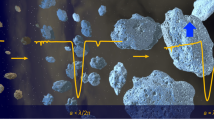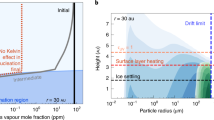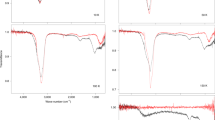Abstract
Abundances and the partitioning between ices and gases in gas–grain chemistry are governed by adsorption and desorption on grains. Understanding of astrophysical observations relies on laboratory measurements of adsorption and desorption rates on dust grains analogues. On flat surfaces, gas adsorption probabilities (or sticking coefficients) have been found to be close to unity for most gases1,2,3. Here we report a strong decrease in the sticking coefficients of H2O and CO2 on substrates more akin to cosmic dust, such as submicrometre-sized particles of carbon and olivine, bare or covered with ice. This effect results from the local curvature of the grains, and then extends to larger grains made of aggregated small particles, such as fluffy or porous dust in more evolved media (for example, circumstellar disks). The main astrophysical implication is that accretion rates of gases are reduced accordingly, slowing the growth of cosmic ices. Furthermore, volatile species that are not adsorbed on a grain at their freeze-out temperature will persist in the gas phase, which will impact gas–ice partitions. We also found that thermal desorption of H2O is not modified by grain size, and thus the temperature of snowlines should be independent of the dust size distribution.
This is a preview of subscription content, access via your institution
Access options
Access Nature and 54 other Nature Portfolio journals
Get Nature+, our best-value online-access subscription
$29.99 / 30 days
cancel any time
Subscribe to this journal
Receive 12 digital issues and online access to articles
$119.00 per year
only $9.92 per issue
Buy this article
- Purchase on Springer Link
- Instant access to full article PDF
Prices may be subject to local taxes which are calculated during checkout



Similar content being viewed by others
Data availability
A text version of Table 1 is available at https://figshare.com/articles/dataset/_/13274840. All of the datasets generated and analysed during the current study are available from the corresponding author on reasonable request.
References
Smith, R. S. & Kay, B. D. Molecular beam studies of kinetic processes in nanoscale water films. Surf. Rev. Lett. 4, 781–797 (1997).
Chaabouni, H. et al. Sticking coefficient of hydrogen and deuterium on silicates under interstellar conditions. Astron. Astrophys. 358, A128 (2012).
He, J., Acharyya, K. & Vidali, G. Sticking of molecules on nonporous amorphous water ice. Astrophys. J. 823, 56 (2016).
Weingartner, J. C. & Draine, B. T. Dust grain-size distributions and extinction in the Milky Way, Large Magellanic Cloud, and Small Magellanic Cloud. Astrophys. J. 548, 296–309 (2001).
Köhler, M. et al. Dust coagulation processes as constrained by far-infrared. Astron. Astrophys. 548, A61 (2012).
Blum, J. Dust evolution in protoplanetary discs and the formation of planetesimals: what have we learned from laboratory experiments? Space Sci. Rev. 214, 52 (2018).
Linnartz, H., Ioppolo, S. & Fedoseev, G. Atom addition reactions in interstellar ice analogues. Int. Rev. Phys. Chem. 34, 205–237 (2015).
Oberg, K. Photochemistry and astrochemistry: photochemical pathways to interstellar complex organic molecules. Chem. Rev. 116, 9631–9663 (2016).
Potapov, A., Jäger, C., Henning, T., Jonusas, M. & Krim, L. The formation of formaldehyde on interstellar carbonaceous grain analogs by O/H atom addition. Astrophys. J. 846, 131 (2017).
Mennella, V. HD formation by abstraction of H/D chemisorbed in carbon grains with D/H atoms under simulated interstellar conditions. Astrophys. J. 684, L25–L28 (2008).
Maté, B., Jimenez-Redondo, M., Pelaez, R., Tanarro, I. & Herrero, V. Desorption of N2, CO, CH4 and CO2 from interstellar carbonaceous dust analogues. Mon. Not. R. Astron. Soc. 490, 2936–2947 (2019).
Potapov, A., Theulé, P., Jäger, C. & Henning, T. Evidence of surface catalytic effect on cosmic dust grain analogs: the ammonia and carbon dioxide surface reaction. Astrophys. J. 878, L20 (2019).
Mautner, M. N. et al. Meteorite nanoparticles as models for interstellar grains: synthesis and preliminary characterisation. Faraday Discuss. 133, 103–112 (2006).
He, J., Frank, P. & Vidali, G. Interaction of hydrogen with surfaces of silicates: single crystal vs. amorphous. Phys. Chem. Chem. Phys. 13, 15803–15809 (2011).
Potapov, A., Jäger, C. & Henning, T. Temperature programmed desorption of water ice from the surface of amorphous carbon and silicate grains as related to planet-forming disks. Astrophys. J. 865, 58 (2018).
Zubko, V., Dwek, E. & Arendt, R. G. Interstellar dust models consistent with extinction, emission and abundance constraints. Astrophys. J. Suppl. Ser. 152, 211–249 (2004).
Chakarov, D. V., Österlund, L. & Kasemo, B. Water adsorption on graphite (0001). Vacuum 46, 1109–1112 (1995).
Souda, R. Substrate and surfactant effects on the glass-liquid transition of thin water films. J. Phys. Chem. B 110, 17524–17530 (2006).
Noble, J. A., Congiu, E., Dulieu, F. & Fraser, H. J. Thermal desorption characteristics of CO, O2 and CO2 on non-porous water, crystalline water and silicate surfaces at submonolayer and multilayer coverages. Mon. Not. R. Astron. Soc. 421, 768–779 (2012).
Hoose, C. & Möhler, O. Heterogeneous ice nucleation on atmospheric aerosols: a review of results from laboratory experiments. Atmos. Chem. Phys. 12, 9817–9854 (2012).
Fisher, L. R., Gamble, R. A. & Middlehurst, J. The Kelvin equation and the capillary condensation of water. Nature 290, 575–576 (1981).
Dusek, U. et al. Size matters more than chemistry for cloud-nucleating ability of aerosol particles. Science 312, 1375–1378 (2006).
Xu, Y. et al. Selective nucleation of ice crystals depending on the inclination angle of nanostructures. Phys. Chem. Chem. Phys. 22, 1168–1173 (2020).
Al-Halabi, A., Fraser, H. J., Kroes, G. J. & Van Dishoeck, E. F. Adsorption of CO on amorphous water-ice surfaces. Astron. Astrophys. 422, 777–791 (2004).
Buch, V., Delzeit, L., Blackledge, C. & Devlin, J. P. Structure of the ice nanocrystal surface from simulated versus experimental spectra of adsorbed CF4. J. Phys. Chem. 100, 3732–3744 (1996).
Buch, V. & Czerminski, R. Eigenstates of a quantum-mechanical particle on a topologically disordered surface: H(D) atom physisorbed on an amorphous ice cluster (H2O)115. J. Chem. Phys. 95, 6026–6038 (1991).
Cuppen, H. M. et al. Grain surface models and data for astrochemistry. Space Sci. Rev. 212, 1–58 (2017).
Henning, T. & Semenov, D. Chemistry in protoplanetary disks. Chem. Rev. 113, 9016–9042 (2013).
Redman, M. P., Rawlings, J. M. C., Nutter, D. J. & Williams, D. A. Molecular gas freeze-out in the pre-stellar core L1689B. Mon. Not. R. Astron. Soc. 337, L17–L21 (2002).
Krijt, S., Ciesla, F. J. & Bergin, E. A. Tracing water vapor and ice during dust growth. Astrophys. J. 833, 285 (2016).
Marhaba, I. et al. Aircraft and MiniCAST soot at the nanoscale. Combust. Flame 204, 278–289 (2019).
Parent, P., Laffon, C., Mangeney, C., Bournel, F. & Tronc, M. Structure of the water ice surface studied by x-ray absorption spectroscopy at the O K-edge. J. Chem. Phys. 117, 10842–10851 (2002).
He, J. et al. The effective surface area of amorphous solid water measured by the infrared absorption of carbon monoxide. Astrophys. J. 878, 94 (2019).
Grimmelmann, E. K., Tully, J. C. & Cardillo, M. J. Hard-cube model analysis of gas-surface energy accommodation. J. Chem. Phys. 72, 1039–1043 (1980).
Bolton, K., Svanberg, M. & Pettersson, J. B. C. Classical trajectory study of argon-ice collision dynamics. J. Chem. Phys. 110, 5380–5391 (1999).
Kohrt, C. & Gomer, R. Adsorption of CO on the (110) plane of tungsten; temperature dependence of the sticking coefficient and absolute surface coverages. Surf. Sci. 40, 71–84 (1973).
Al-Halabi, A., Kleyn, A. W., Van Dishoeck, E. F. & Kroes, G. J. Sticking of hydrogen atoms to crystalline ice surfaces: dependence on incidence energy and surface temperature. J. Phys. Chem. B 106, 6515–6522 (2002).
Buch, V. & Zhang, Q. Sticking probability of H and D atoms on amorphous ice: a computational study. Astrophys. J. 379, 647–652 (1991).
Acknowledgements
We thank I. Marhaba for her help during the preliminary XPS experiments, and F.-X. Ouf for providing the MiniCAST samples.
Author information
Authors and Affiliations
Contributions
C.L. and P.P. conceived, performed, analysed and interpreted the XPS experiments. O.G. provided and prepared most of the samples, and carried out the X-ray diffraction experiments. D.F. and O.G. performed and analysed the scanning and transmission electron microscopy images. P.P. wrote the manuscript. All authors contributed ideas to this Letter.
Corresponding author
Ethics declarations
Competing interests
The authors declare no competing interests.
Additional information
Peer review information Nature Astronomy thanks Kinsuk Acharyya, Guido Condorelli and the other, anonymous, reviewer(s) for their contribution to the peer review of this work.
Publisher’s note Springer Nature remains neutral with regard to jurisdictional claims in published maps and institutional affiliations.
Supplementary information
Supplementary Information
Supplementary Information 1–5, Figs. 1–5 and references.
Rights and permissions
About this article
Cite this article
Laffon, C., Ferry, D., Grauby, O. et al. Laboratory-based sticking coefficients for ices on a variety of small-grain analogues. Nat Astron 5, 445–450 (2021). https://doi.org/10.1038/s41550-020-01288-7
Received:
Accepted:
Published:
Issue Date:
DOI: https://doi.org/10.1038/s41550-020-01288-7
This article is cited by
-
Depletion of gaseous CO in protoplanetary disks by surface-energy-regulated ice formation
Nature Astronomy (2022)



